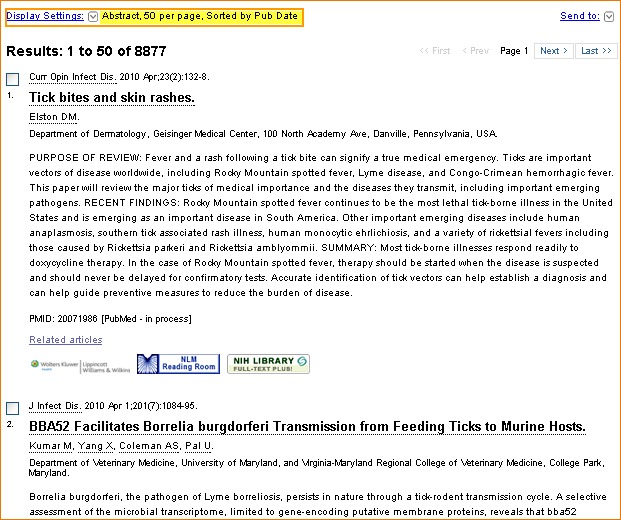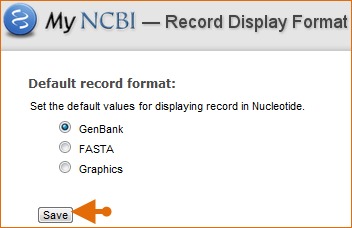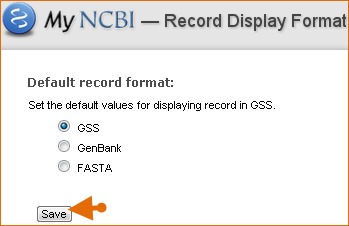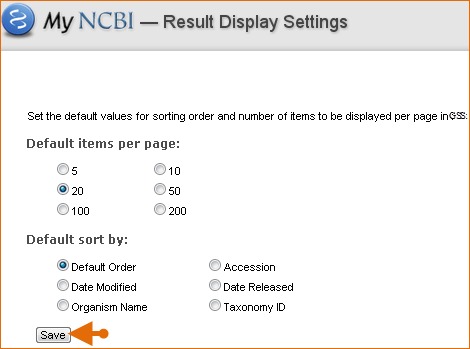NCBI Bookshelf. A service of the National Library of Medicine, National Institutes of Health.
My NCBI Help [Internet]. Bethesda (MD): National Center for Biotechnology Information (US); 2005-.
My NCBI preferences and customization links can be found at the top right corner of the My NCBI homepage.

Users can customize the appearance of the My NCBI homepage display and select their preferences for: displaying the links menu, activating search term highlighting, saving shared settings, setting up and activating filters, customizing search results display and turning off the Auto Suggest feature and Search Details ad for PubMed.
Section Contents
- Account Settings
- Common Preferences
- PubMed Preferences
- Gene Preferences
- GTR Preferences
- Nucleotide Preferences
- Protein Preferences
- GSS Preferences
- EST Preferences
Customizing the My NCBI Homepage
The homepage display can be customized by dragging and dropping each function window to the top or bottom of the page. Each function window can also be minimized or removed from the homepage display. To see a video tutorial of the display customizer click 
Users may select or deselect any of the function windows from appearing in the My NCBI homepage. To deselect any function window, click on the “Customize this page” link and uncheck any of the functions that you do not want to see in your My NCBI homepage.

Account Settings
After signing in to your My NCBI account, click on your username on the NCBI header to access the Account Settings page.

Changing your E-mail Address
To change your e-mail address:
- 1.
Click on your Username to access the Account Settings page
- 2.
Click the “Change” button next to the current e-mail address
- 3.
Enter your account password
- 4.
Enter an e-mail address
- 5.
Click Save.
Note:
- A confirmation e-mail message will be sent to the new e-mail address to activate automatic e-mail updates
- For the Send to E-mail option, you may enter a different address.
Changing your Password
To change your password:
- 1.
Click on your Username to access the Account Settings page
- 2.
Click the “Change” button
- 3.
Enter your current account password
- 4.
Enter your new account password and repeat the new account password
- 5.
Click Save.
Changing your Security Question
To change your security question:
- 1.
Click on your Username to access the Account Settings page
- 2.
Click the “Change” button next to the security question
- 3.
Enter your account password
- 4.
Enter a security question and answer
- 5.
Click Save.
Linked Accounts
Go to “Linked Accounts” to view or remove partner organization accounts that are currently linked to your My NCBI account. You may also search for a different partner account to link to your My NCBI account.
To view or delete linked accounts:
- 1.
Click on your Username to access the Account Settings page
- 2.
Click the “Change” button next to Linked Accounts
- 3.
To remove a linked account, click on the red X.
- 4.
Click Save.
To link your My NCBI account to a partner account: repeat steps 1 and 2 and search for a partner account. If available, click on the partner organization link displayed. Then, log in at the partner organization page with your partner organization credentials.

Adding and Removing Delegates
Delegates are persons who are granted access by NCBI account owners to view and manage their My Bibliography collection and/or their SciENcv profile. Delegate invitations are initiated by NCBI account owners.
To add a delegate to manage your My Bibliography and/or SciENcv data:
- 1.
Log in to your NCBI account, and click on your username(top right corner of page) to access the Account Settings page
- 2.
Go to the “Delegates” section and click “Add a Delegate” link
- 3.
Enter the delegate’s e-mail address, and click OK
- 4.
Your delegate will receive an e-mail with a URL that leads to an access confirmation page. For further information, see confirming a My Bibliography connection for delegates.
The Delegates section of the Account Settings page displays a list of all the delegates granted access to either your My Bibliography collection or your SciENCV professional profile, or both. In the Delegates section you may add or remove delegates as well as modify the access granted by checking or unchecking the boxes under the My Bibliography or SciENcv columns. Additionally, delegates can be removed by clicking on the red X.

Creating an API Key
Web services developers and other users of NCBI E-Utilities can create an API key in Account Settings. An API key is required for Web service requests set up to make more than three requests per second to E-Utilities.

Use the API key generated for your account in your request URLs with the api_key parameter and you will be able to make up to ten requests per second. For example: esummary.fcgi?db=pubmed&id=28933509&api_key= 21abcd97ef62XXXXXXXXXX
Users who need to make more than ten requests per second should contact eutilities@ncbi.nlm.nih.gov.
To create an API key using your NCBI account:
- 1.
Click on your Username to access the Account Settings page
- 2.
Go to the “API Key Management” section and click the button “Create an API key”
- 3.
An API Key will be generated for you.
- 4.
Click the “Replace” button to generate a new API key. Note that the previously issued API key will be inactivated.
Common Preferences
Changing the Links Menu Display
Users can change the display of the Links menu on any results page. To change the display format of the Links menu, click on Links Display located in the NCBI Site Preferences section of My NCBI. The available formats are:
- Pop-up Window: Opens a separate small window with link selections(uses JavaScript)
- Plain Links: Displays links as separate selections

Highlighting Search Terms
You can choose to have your search terms highlighted in retrieved database records. By default this option is off, but you can pick one of the ten colors available in the Highlighting section of the NCBI Site Preferences to have your search terms highlighted. Highlighting is only active when you are signed into My NCBI.
Terms other than the one(s) you have used in your query are also highlighted at times. For example, if you search PubMed using the term ‘cancer’, you will also find citations with the term ‘neoplasm’ highlighted. That is because the NCBI search engine has a dictionary of synonymous terms, such as ‘cancer’ and ‘neoplasm’ that are equally considered when you search a database using one of them.
In some cases, you will retrieve PubMed citations that have no highlighting in its abstract, which means that neither the search term nor a synonymous word was found in the abstract of the article. However, terms that appear as MeSH (Medical Subject Headings) terms or Substances on a record will be highlighted in the supplemental information section of the citation. For example, a search in PubMed with the term ABCD4 retrieves, among others, the following record that does not have the term ABCD4 (or any synonymous term) in its abstract: The four murine peroxisomal ABC-transporter genes differ in constitutive, inducible and developmental expression.
Just scroll to the bottom of the page and expand the Publication Types, MeSH Terms list (see image below), and you will see that the term ABCD4 (full term “ABCD4 protein, mouse”) appears in the record.

Note:
- MeSH is the National Library of Medicine's controlled vocabulary thesaurus. It consists of sets of terms naming descriptors in a hierarchical structure that permits searching at various levels of specificity. Click here for more information on how to search the MeSH database
Turning Off Auto Suggest
The Auto Suggest feature is defaulted to be on whenever users start typing in search terms. When users start typing letters into the PubMed search box, Auto Suggest will suggest some of the most popular PubMed searches. You can click on any of the suggested terms.

To turn off the Auto Suggest feature scroll to the bottom of the Auto Suggest menu when you start to type in a term. There is a Turn Off option.
To turn the Auto Suggest feature back on, go to your My NCBI page. Click the NCBI Site Preferences link, click the “Auto Suggest” link and then click the radio button for On.

Note: The Auto Suggest feature will be turned back on after eight hours of inactivity.
PubMed Preferences
Changing the Abstract Supplemental Data Display
The Abstract Supplemental Data display lists MeSH terms, Publication Types and other supplemental information when clicking on the plus button (+).

To change the Abstract format to display the supplemental information:
- 1.
Click Abstract supplemental data
- 2.
Check Open
Save

Document Delivery
Document Delivery is a feature of PubMed that allows you to order articles described in PubMed citations from an institution of your choice. By default, orders are sent to Loansome Doc, the document delivery service of the National Library of Medicine. To change the DDS for your orders, go to NCBI Site Preferences, click the Document Delivery link under PubMed Preferences, and then choose a service from the list of institutions found there. After you have made your selection, your orders will be sent to the selected institution.
Please note that Document Delivery Service providers may restrict the service to affiliated users or may charge for document delivery.
To order documents, click the checkbox next to the article(s) you want to order. When you are ready to order, select Order from the Send to pull-down menu, as shown below. You will be directed to the Document Delivery Service form.

You can mark several citations to be included in a single order. Alternatively, before ordering all your selections, you can save them temporarily in the Clipboard. To send your selections to the Clipboard, proceed as usual but select Clipboard from the Send to pull-down menu, instead of Order. When you have decided what articles you want to order, click the Clipboard link. To remove unwanted articles from the Clipboard, click the Remove from Clipboard link next to the citation. When you are ready to order, select Order from the Send to pull-down menu. You will be directed to the Document Delivery Service form. Complete the requested information.
Your DDS selection is active only while signed into My NCBI. When you sign out, the DDS default (Loansome Doc) choice is restored. Document delivery services sponsored by some institutions might be available only to users of that institution. Some institutions may also charge a fee for their services.
Setting Up PubMed Filters and Icons
NCBI databases search results can be narrowed down to smaller groups of data using filters. You can select your preferred PubMed filters to be active every time you run a search. For example, filters can be used to group results into reviews, clinical trials, or citations with free full text links, among other choices. You may also create your own custom filters. There is a limit of 15 filters for the PubMed database. For a detailed explanation on how to set up filters, see Working with Filters.
Libraries using LinkOut to display their holdings in PubMed can set up a filter for their holdings through My NCBI. Click on the link “PubMed Filters and Icons” under PubMed Preferences. Select the radio button for LinkOut. Enter your library name in the filter search box. Check the box under the “Filter” column. In addition, to display the library icon, check the box under the “Link Icon” column.

For full documentation on LinkOut, see LinkOut Help.
Outside Tool
Outside Tool allows libraries to add a link from PubMed citations to a link resolver available at their institution. These links are displayed as icons in the PubMed Abstract display (see image below).

When you click on the icon, you are directed to the available services for that citation offered by the sponsoring library. These services might include access to electronic full text or information on local print holdings.
To turn on an Outside Tool, click the Outside Tool link. Select an institution from the available list and click Save; the selected icon will display in the Abstract format. Keep in mind that most Outside Tools are fully accessible only to individuals affiliated with the sponsoring institution.
You can also choose to have Outside Tool icons included in your PubMed automatic e-mail search updates (see Setting up Automatic E-mail Updates). To do this, select Abstract as the display format for your e-mails when setting up your search alert. The Outside Tool icon that you have selected in My NCBI will be included in your e-mail alerts, together with your PubMed search updates. To view a brief animated tutorial, see Selecting Your Outside Tool Preference.
For more information on Outside Tool, see http://www.ncbi.nlm.nih.gov/books/NBK3803/#related.Outside_Tool
Author Information Display
The author information appears in the PubMed abstract display below the author names, and it is normally closed by default:

To change the default to make the author information available in the abstract display:
- 1.
Click the link Author Information under PubMed preferences
- 2.
Check Open
Save

The author information will be available when signed in to My NCBI.

Customizing the Search Results Display
The PubMed default settings for displaying search results are: Summary display format, 20 citations per page, and sorted by recently added citations listed first. To customize your search results display, log into My NCBI and click “NCBI Site Preferences” and then “Result Display Settings” under PubMed Preferences. In the resulting page select, either the Abstract or the Summary format, the number of citations to be displayed per page and a sort option among the following: Recently Added, Pub Date (Publication Date), First Author, Last Author, Journal, Title or Relevance.

After your results display selections are saved in My NCBI and while logged into My NCBI, go to PubMed to see your display selections applied to your search results. In the image below the customized display selections appear next to the “Display Settings” drop-down menu.

Note:
- You must be signed into My NCBI for your display selections to be applied to your PubMed search results
Gene Preferences
Setting up Gene Filters
NCBI databases search results can be narrowed down to smaller groups of data using filters. You can select your preferred Gene filters to be active every time you run a search. You may also create your own custom filters.
There is a limit of 5 filters for the Gene database. For a detailed explanation on how to set up filters in My NCBI, see Working with Filters. To see an explanation of the different types of filters available for the Gene database see Gene Help-filters.
Changing the Record Display Format
The Gene database default format for displaying search results is Full report. The full report display includes the following sections: Summary, Genomic regions/transcripts/products, Genomic Context, Bibliography, Phenotypes, HIV-1 protein interactions, Interactions, Alleles, General Gene Information, General Protein Information, NCBI Reference Sequences (RefSeq), Related Sequences, and Additional Links.
To customize your records display format, log into My NCBI and click “NCBI Site Preferences” and then click “Record Display Format” under Gene Preferences. In the resulting page select either the Full report, Gene Table, or Gene RIF format. You can specify the sections you want included in the Full report by checking the box next to the section name. For information on the different types of display formats available for the Gene database see Gene Help-display/settings.

Customizing the Search Results Display
The Gene database default settings for displaying search results are: 20 records per page, and sorted by Relevance. To customize your search results display, log into My NCBI and click “NCBI Site Preferences” and then click “Result Display Settings” under Gene Preferences. In the resulting page, select the number of records to be displayed per page (5, 10, 20, 50, 100, or 200) and the sort order (Relevance, Name, Gene Weight or Chromosome).

For information on Display Settings in the Gene Database, see Gene Help.
GTR Preferences
Selecting Preferred Labs
You can select your preferred Laboratories for the Genetic Testing Registry (GTR) database using My NCBI, which will help limit your search results to the tests offered by the laboratories selected.
In NCBI Site Preferences:
- 1.
Click the link “Preferred Labs” under GTR preferences.
- 2.
Click “GTR Website.” Enter a lab name in the search box.
- 3.
Click the button “Add to preferred labs”

Nucleotide Preferences
Changing the Record Display Format
The Nucleotide database default format for displaying search results is GenBank. To customize your records display format, log into My NCBI and click “NCBI Site Preferences” and then click “Record Display Format” under Nucleotide Preferences. In the resulting page select either the GenBank, FASTA, or Graphics format. For information on the different types of display formats available for the Nucleotide database see Nucleotide FAQ
 .
.
Customizing the Search Results Display
The Nucleotide database default settings for displaying search results are: 20 records per page, and sorted by Default Order. Default order follows the same display order as GenBank: last into the database first displayed. To customize your search results display, log into My NCBI and click “NCBI Site Preferences” and then click “Result Display Settings” under Nucleotide Preferences. In the resulting page select, the number of records to be displayed per page (5, 10, 20, 50, 100, or 200) and the sort order (Default Order, Accession, Date Modified, Date Released, Organism Name or Taxonomy ID Name).

For information on Display Settings in the Nucleotide Database, see Nucleotide FAQ.
Protein Preferences
Changing the Record Display Format
The Protein database default format for displaying search results is GenBank. To customize your records display format, log into My NCBI and click “NCBI Site Preferences” and then click “Record Display Format” under Protein Preferences. In the resulting page select either the GenBank, FASTA, or Graphics format. For information on the different types of display formats available for the Protein database see Protein FAQ.

Customizing the Search Results Display
The Protein database default settings for displaying search results are: 20 records per page, and sorted by Default Order. Default order follows the same display order as GenBank: last into the database first displayed. To customize your search results display, log into My NCBI and click “NCBI Site Preferences” and then click “Result Display Settings” under Protein Preferences. In the resulting page select, the number of records to be displayed per page (5, 10, 20, 50, 100, or 200) and the sort order (Default Order, Accession, Date Modified, Date Released, Organism Name or Taxonomy ID Name).

For information on Display Settings in the Protein Database, see Protein FAQ..
GSS Preferences
Changing the Record Display Format
The GSS (Genome Survey Sequence) database default format for displaying search results is GSS. To customize your records display format, log into My NCBI and click “NCBI Site Preferences” and then click “Record Display Format” under GSS Preferences. In the resulting page select, either GSS, GenBank or FASTA format. For information on the GSS database see Entrez Sequences Help.

Customizing the Search Results Display
The GSS database default settings for displaying search results are: 20 records per page, and sorted by Default Order. Default order follows the same display order as GenBank: last into the database first displayed. To customize your search results display, log into My NCBI and click “NCBI Site Preferences” and then click “Result Display Settings” under GSS Preferences. In the resulting page select, the number of records to be displayed per page (5, 10, 20, 50, 100, or 200) and the sort order (Default Order, Accession, Date Modified, Date Released, Organism Name or Taxonomy ID Name).

EST Preferences
Changing the Record Display Format
The EST (Expressed Sequence Tag) database default format for displaying search results is EST. To customize your records display format, log into My NCBI and click “NCBI Site Preferences” and then click “Record Display Format” under EST Preferences. In the resulting page select, either EST, GenBank or FASTA format. For information on the EST database see Entrez Sequences Help.

Customizing the Search Results Display
The EST database default settings for displaying search results are: 20 records per page, and sorted by Default Order. Default order follows the same display order as GenBank: last into the database first displayed. To customize your search results display, log into My NCBI and click “NCBI Site Preferences” and then click “Result Display Settings” under EST Preferences. In the resulting page select, the number of records to be displayed per page (5, 10, 20, 50, 100, or 200) and the sort order (Default Order, Accession, Date Modified, Date Released, Organism Name or Taxonomy ID Name).

- Using Preferences - My NCBI HelpUsing Preferences - My NCBI Help
- (Obesity[MeSH] OR Body Mass Index[Mesh]) AND Physician's Practice... (175)(Obesity[MeSH] OR Body Mass Index[Mesh]) AND Physician's Practice Patterns[MeSH] AND United States[MeSH]SearchPubMed
- NCBI Protein Resources - The NCBI HandbookNCBI Protein Resources - The NCBI Handbook
- Eukaryotic Genome Annotation Pipeline - The NCBI HandbookEukaryotic Genome Annotation Pipeline - The NCBI Handbook
- Centers for Disease Control and Prevention AND (CDC) AND Corporat... (0)Centers for Disease Control and Prevention AND (CDC) AND Corporate AuthorSearchPubMed
Your browsing activity is empty.
Activity recording is turned off.
See more...
